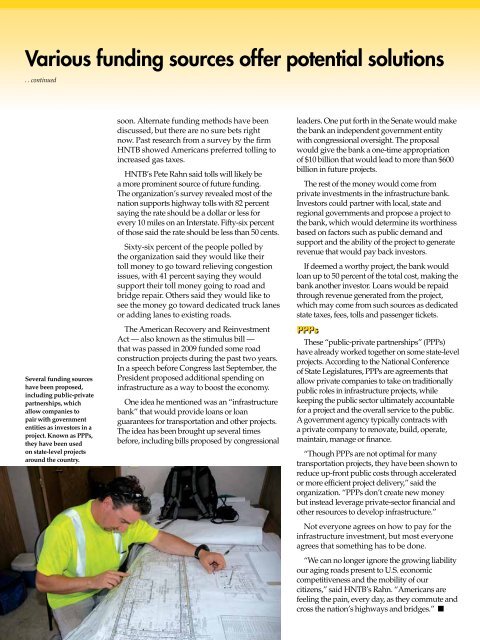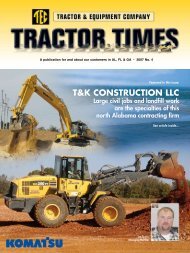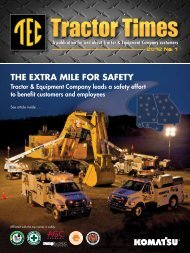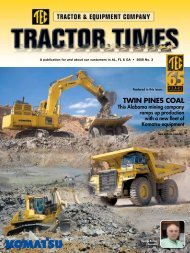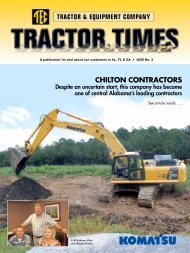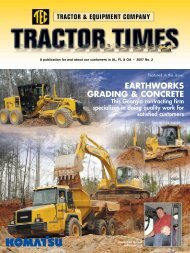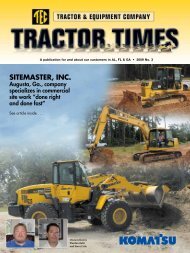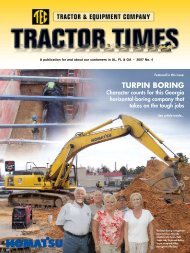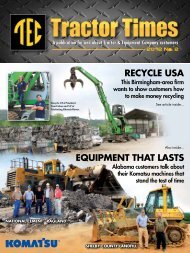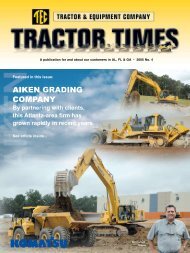CRAWFORD GRADING & PIPELINE, INC. - TEC Tractor Times
CRAWFORD GRADING & PIPELINE, INC. - TEC Tractor Times
CRAWFORD GRADING & PIPELINE, INC. - TEC Tractor Times
- No tags were found...
You also want an ePaper? Increase the reach of your titles
YUMPU automatically turns print PDFs into web optimized ePapers that Google loves.
Various funding sources offer potential solutions. . continuedSeveral funding sourceshave been proposed,including public-privatepartnerships, whichallow companies topair with governmententities as investors in aproject. Known as PPPs,they have been usedon state-level projectsaround the country.soon. Alternate funding methods have beendiscussed, but there are no sure bets rightnow. Past research from a survey by the firmHNTB showed Americans preferred tolling toincreased gas taxes.HNTB’s Pete Rahn said tolls will likely bea more prominent source of future funding.The organization’s survey revealed most of thenation supports highway tolls with 82 percentsaying the rate should be a dollar or less forevery 10 miles on an Interstate. Fifty-six percentof those said the rate should be less than 50 cents.Sixty-six percent of the people polled bythe organization said they would like theirtoll money to go toward relieving congestionissues, with 41 percent saying they wouldsupport their toll money going to road andbridge repair. Others said they would like tosee the money go toward dedicated truck lanesor adding lanes to existing roads.The American Recovery and ReinvestmentAct — also known as the stimulus bill —that was passed in 2009 funded some roadconstruction projects during the past two years.In a speech before Congress last September, thePresident proposed additional spending oninfrastructure as a way to boost the economy.One idea he mentioned was an “infrastructurebank” that would provide loans or loanguarantees for transportation and other projects.The idea has been brought up several timesbefore, including bills proposed by congressionalleaders. One put forth in the Senate would makethe bank an independent government entitywith congressional oversight. The proposalwould give the bank a one-time appropriationof $10 billion that would lead to more than $600billion in future projects.The rest of the money would come fromprivate investments in the infrastructure bank.Investors could partner with local, state andregional governments and propose a project tothe bank, which would determine its worthinessbased on factors such as public demand andsupport and the ability of the project to generaterevenue that would pay back investors.If deemed a worthy project, the bank wouldloan up to 50 percent of the total cost, making thebank another investor. Loans would be repaidthrough revenue generated from the project,which may come from such sources as dedicatedstate taxes, fees, tolls and passenger tickets.PPPsThese “public-private partnerships” (PPPs)have already worked together on some state-levelprojects. According to the National Conferenceof State Legislatures, PPPs are agreements thatallow private companies to take on traditionallypublic roles in infrastructure projects, whilekeeping the public sector ultimately accountablefor a project and the overall service to the public.A government agency typically contracts witha private company to renovate, build, operate,maintain, manage or finance.“Though PPPs are not optimal for manytransportation projects, they have been shown toreduce up-front public costs through acceleratedor more efficient project delivery,” said theorganization. “PPPs don’t create new moneybut instead leverage private-sector financial andother resources to develop infrastructure.”Not everyone agrees on how to pay for theinfrastructure investment, but most everyoneagrees that something has to be done.“We can no longer ignore the growing liabilityour aging roads present to U.S. economiccompetitiveness and the mobility of ourcitizens,” said HNTB’s Rahn. “Americans arefeeling the pain, every day, as they commute andcross the nation’s highways and bridges.” n


